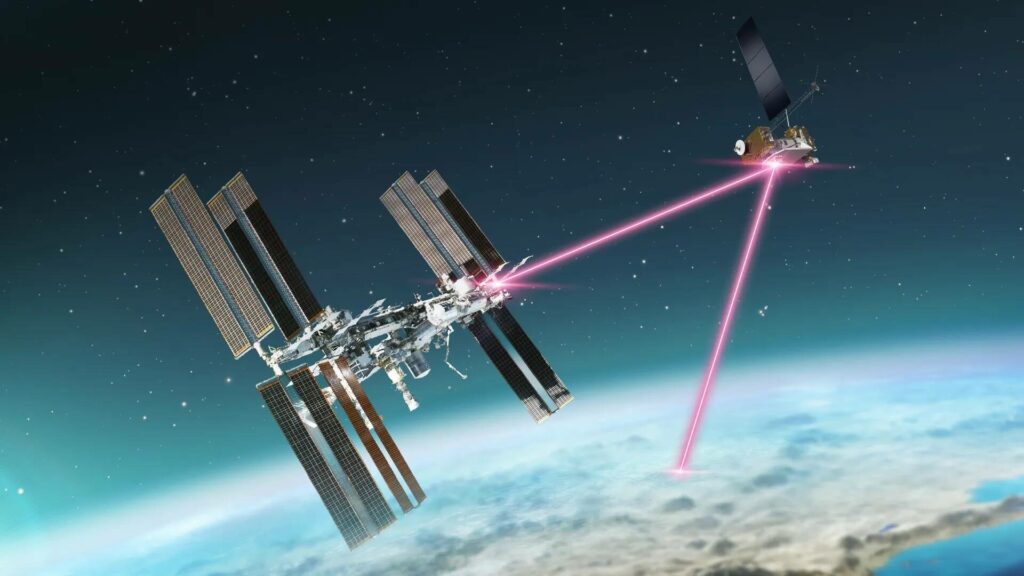Jealous of the fact that the International Space Station has better internet than you do? Well, here’s one more benchmark to envy: NASA has successfully streamed 4K video from an in-flight aircraft to the ISS and back again.
As part of its ongoing effort to make optical communication the standard for future space missions, NASA conducted a series of tests beginning in late May where it installed a laser terminal on a small single-engine aircraft. That aircraft streamed 4K video while flying over Lake Erie to a ground station in Cleveland, Ohio, which was transmitted to NASA’s White Sands Test Facility. From there, the signal was sent to NASA’s Laser Communications Relay Demonstration (LCRD) satellite, which relayed it to the ISS.
The ISS received the signal via its Integrated LCRD Low Earth Orbit User Modem and Amplifier Terminal, or ILLUMA-T, before sending it back to Earth.
A simulation of the data path used in NASA’s experiment sending 4K video to the ISS via lasers – click to enlarge
Despite all that distance, wireless transmission, and weather, NASA said it still managed to achieve data transmission speeds in excess of 900 Mbps. The average household internet connection in the US, meanwhile, is a measly 245 Mbps as of June 2024.
“These experiments are a tremendous accomplishment,” said Dr Daniel Raible, principal investigator for NASA’s High-Rate Delay Tolerant Networking (HDTN) project. “We can now build upon the success of streaming 4K HD videos to and from the space station to provide future capabilities, like HD videoconferencing, for our Artemis astronauts, which will be important for crew health and activity coordination.”
NASA hopes the same technology will also allow it to live stream future Moon landings and missions back to Earth in near real time.
HDTN is a critical component of the experiment, and serves as an upgrade for NASA’s aging DTN protocol that’s been part of space networking since the early 2000s. HDTN connections are four times faster thanks to the inclusion of support for laser optical communications, NASA said.
UK university gets £5M to strap lasers to CubeSats
Boffins shatter data transmission speed record
Tool bag lost in space now tracked by garbage watchers
Forget that Loon’s balloon burst, we just fired 700TB of laser broadband between two cities, says Alphabet
Like DTN, HDTN allows various nodes in a ground-to-space network to store data in case of signal interruption, and also shunts data from one node to another if a clear signal is available between different connections.
NASA has been performing test flights with the laser-equipped aircraft since May 30, and it took boffins at NASA’s Glenn Research Center until June 26 to finally complete the loop to the ISS. We’re told NASA has flown multiple tests flights per day, and has undertaken 14 days of test flights since the end of May, totaling more than 48 hours of in-flight testing.
After each test, a number of performance tweaks were made to the HDTN network, a NASA spokesperson told The Register. Those tweaks included configuration updates across the network (on the ISS, ground nodes, and the Glenn network) as well as adjustments to network transmission by tuning the number of bundles and real-time transport protocol packets being sent.
“We’ve been releasing several new features to our open-source HDTN software in the pursuit of building a Solar System Internet such as chat applications, email services, security, clock synchronizations and audio and video streaming services,” Raible told us. “Right now, we are artificially inducing delays into the links so we can utilize the aircraft to represent a lunar spacecraft, and evaluate the resulting network performance.”
Alas, the experiment is now at an end – at least as far as the ISS is concerned.
The ILLUMA-T module, which allowed the ISS to receive the 4K video in the latest experiment, and pet photographs in a previous one (separate from the deep-space cat video transmission), reached the end of its experimental life on June 29. NASA jettisoned the module from the station late last month after six months of use, and it’s now orbiting Earth until it burns up on re-entry in the next few years, we’re told.
NASA plans to continue tests of 4K video transmission between the plane and the LCRD until the end of the month without the involvement of the ISS. After that, we’ll have to wait until the Artemis II mission, expected to launch late next year, for the next big test of laser communications.
Similar systems are also being tested in deep space, with NASA managing to make optical contact with the Psyche probe, currently more than 140 million miles (226 million kilometers) away from Earth.
That’s roughly the average distance from our watery oasis to the sandy shores of Mars, so hopefully by the time humans land on the Red Planet YouTube will be just a click away. ®
>>> Read full article>>>
Copyright for syndicated content belongs to the linked Source : The Register – https://go.theregister.com/feed/www.theregister.com/2024/07/25/nasa_4k_video_iss/
